Forests protect the soil; selviculture not always
2006/11/01 Lexartza Artza, Irantzu - Elhuyar Zientziaren Komunikazioa Iturria: Elhuyar aldizkaria
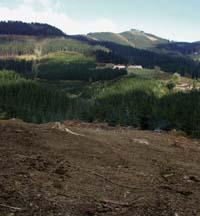
In the last century the hillsides of our village changed a lot. In a few decades, the landscapes bare by deforestation were filled with pine and today the primary sector of the Autonomous Community of the Basque Country is of great importance. XX. From the mid-twentieth century, the forest surface has multiplied by four throughout the territory, being one of the main reasons the monoculture of the foreign species Pinus radiata. In their plantations more than 80% of the wood coming from the forest sector is produced annually.
In addition to changing the appearance of the hillsides, the methods of exploitation of the forest changed over time. In some areas, with the aim of improving their profitability, various machined techniques for obtaining wood and cleaning and soil preparation were used. This increased the fertility of forests, but also raised some concern, since these methods in some cases are very harmful.
The new techniques adopted to replace the short manuals and traditional systems that deposited the remains in the soil, eliminate the remains, and transform the physical and chemical properties of the original soils. In addition, the use of heavy machinery in steep areas can strengthen erosion and reduce the nutrients present in the soil. This can eventually lead to a depletion of the soil.
Aware of this problem, the means to protect the soil or not damage it have multiplied and, in some cases, machined techniques have not been used or rejected. For example, EU and ACBC regulations also promote other methods, but machined methods are still used in some areas.
Soil nutrients
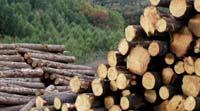
The nutrient content is a good indicator of the state of the soil, it is an important factor for forest growth, but it is also of great utility for the investigation of the forest condition.
In the natural cycle, nutrients are recycled within the ecosystem. The plants assume these nutrients from the soil and the fallen leaves of the trees, etc. They return them to the ground. However, once the trees are cut, the biomass is extracted from the forest, so the nutrients leave the system. Erosion and filtration also extracts nutrients from the system, while the addition is made by atmospheric deposition and erosion of stones, but these processes are very slow compared to those that occur in the cycle itself.
Based on the nutrient cycle, it is observed that interventions on forest ecosystems can influence the state of nutrients in the future. Therefore, it is important to carry out research to know the changes that the intervention produces and predict future changes.
Precisely because of the importance of the pine industry, numerous field studies have been carried out on the exploitation of this species. In some of them, the influence of exploitation techniques on the soil has been studied. J.M. UPV Edeso and A of the University of Santiago de Compostela. The group led by Merino, for example, has compared growth by different methods with nutrient content. For this purpose, a follow-up has been made of the state of some plots in the years after the felling of pines and the planting of new plants.
In these comparisons, no major changes have been observed in cultivated lands with conventional methods, neither in tree growth nor in nutrient content. In fact, in conventional methods the remains are deposited in the soil and its decomposition balances the balance of nutrients. However, in cases where humus and remains have been eliminated, a decrease in nutrients has been observed in the upper layer of the soil after logging, sometimes up to 50%.
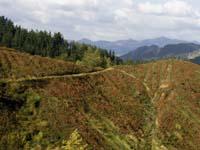
Likewise, after the mechanized preparation of the soil, the nutrients and the organic matter of the upper layer are reduced. The decrease in fertility also affects the productivity of the trees, reaching the conclusion that in the lands where the soil mulch is eliminated, the growth is reduced considerably.
In some cases it has been observed that, years after mechanical exploitation, the decrease in organic matter and nutrients was still evident. Growth in some plantations has been similar or better in the first three or four years of compact preparations, probably due to the lack of competition of new plants. Ten years later, however, they have seen worse production and sometimes less development in some forests.
The lowest values have been given in those cases in which the whole process has been carried out by machining, once all the waste and humus have been eliminated and it has been hit under the slope. It seems that the mixture of soil layers can also influence, as the deeper layers are not so rich in organic matter and nutrients available. In these cases, in addition, erosion can increase, as the waste removed and the humus layer protect the soil.
Soil Simulation Soil Simulation
Computer simulations can also be performed to analyze the nutrient balance. In a project for the Master in Environmental Sciences LUMES of the University of Lund, we have carried out simulations through the iThink/STELLA 8.1 program. This program uses simulation algorithms of the Euler method to complete the model. The conditions and forestry work in mature and young forests have been taken into account. To simulate the nutrient balance, we have based ourselves on the principle of mass conservation, after seeing the entire recycling process.
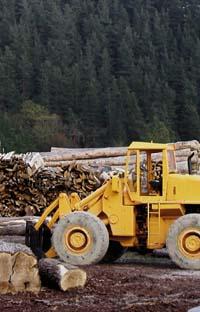
We have tried different situations simulating soil conditions, nutrient content, inputs, outputs, recycling pathways, production, etc., to make a forecast of up to one hundred years. The calibration of the model also allows to simulate past situations.
In the study three main types of situations have been simulated: one, in the traditional method, there is practically no machining and the cutting residues are deposited in the place; the second, with an average degree of machining and the elimination of the organic matter and of the residues; the third, more compact, with heavy machinery for practically all the work, elimination of the organic matter and ploughing of the soil for its preparation.
In the predictions of the model the observed in field research is corroborated: in cases where mechanical methods are used, a negative balance is often obtained. The more rotations, the more evident is this negative effect, and as the level of machining increases the negative effect also increases.
The output (eliminated from the cycle) increases when biomass and organic matter are eliminated and soil is mixed. In fact, nutrients are eliminated when the biomass is removed in the short, but when the remains are deposited, some return to the system, balancing the balance of the elements. On the other hand, the impact of the decomposition of the waste decreases when after the cuts all the remains are removed and the humus layer is removed. The production is limited by the least available necessary elements. Therefore, in the following rotations, a decrease is observed when the most harmful techniques are used.
All this can be deduced from predictions that occur without taking into account the influence of erosion. However, an increase in erosion increases the negative effects. On the other hand, only physical processes have been taken into account. In the simulation, other aspects have not been taken into account, such as the influence of intensive cultivation, drugs, the consequences of climate change, etc.
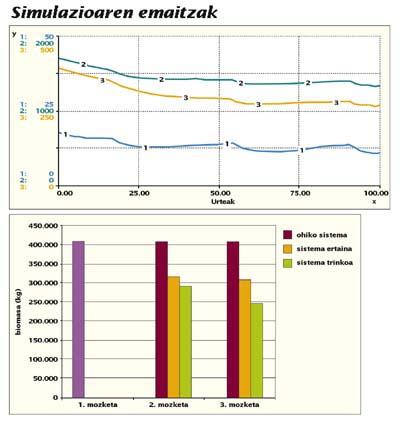
The results are not daily, but neither in the long term. Forest owners who have planted new trees after having used a complete machining may not see their consequences, but it is possible that descendants who receive the following rotation are noticeable in both production and yield.
Article ASSESSING THE SUSTAINABILITY OF FORESTRY IN THE BASQUE COUNTRY: Effects of Management Practices on Soil Conditions in Pinus radiata Plantations (Master in Environmental Sciences of the University of Lund).




